The 21st IEEE International Conference on BioInformatics and BioEngineering
October 25-27, 2021, Kragujevac, Serbia
Aim & Scope
The IEEE International Conference on Bioinformatics & Bioengineering (BIBE) is the first scientific meeting in IEEE that promotes complementary disciplines that hold great promise for the advancement of research and development in complex medical and biological systems, agriculture, environment, public health, drug design, and so on. Research and development in these two areas are impacting the science and technology of fields such as medicine, food production, forensics, etc. by advancing fundamental concepts in molecular biology and in medicine, by helping us understand living organisms at multiple levels, by developing innovative implants and bio-prosthetics, and by improving tools and techniques for the detection, prevention and treatment of diseases.
The BIBE series provides a common platform for the cross fertilization of ideas, and to help shape knowledge and scientific achievements by bridging these two very important and complementary disciplines into an interactive and attractive forum.
Paper Submission
The submissions should contain original, high quality, not submitted or published elsewhere work. Papers should be submitted electronically (through BIBE 2021 web site) in pdf format and should conform to IEEE specifications (single-spaced, double-column, 10-point font size, up to 6 pages).
Paper Presentation
Each accepted paper should be presented by one of the authors and accompanied by at least one full registration fee payment, to guarantee publication in the proceedings. All accepted papers will be included in proceedings of BIBE 2021 that will be published by the IEEE.
Hybrid Participation – Online and Live
IEEE BIBE (BIBE 2021) Now Taking Place as a Hybrid conference with the combination of in-person attendees and virtual attendees.
The safety and well-being of all conference participants is our priority. After evaluating the ongoing COVID-19 situation, the decision has been made to transform the In-Person conference to a Hybrid conference experience – IEEE BIBE 2021 will now be a Hybrid event. Therefore, IEEE BIBE 2021 will take place in Kragujevac Serbia and virtually. The conference dates remain the same – October 25-27, 2021. Proceedings will not be cancelled, and publications will continue as planned.
We will enable authors to participate in the BIBE 2021 Conference and present their papers via the BigBlueButton service. Online and live participation will take place in parallel. Links to virtual rooms will be available to all authors a few days before the BIBE 2021 Conference.
Special issues
Each accepted paper should be presented by one of the authors and accompanied by at least one full registration fee payment, to guarantee publication in the proceedings. All accepted papers will be included in proceedings of BIBE 2021 that will be published by the IEEE.
Best student paper award
Following the tradition and good practice, it is our pleasure to inform you that this year’s BIBE conference has prepared motivating awards for our participants.
Namely, Best student paper award will be awarded to 3 papers in the area od Bioinformatics and 3 papers in the area of Bioengineering in the amount of EUR 200 per paper.
Conference committee will announce the winners on the third day of the conference, at the Closing ceremony.
Awarded Papers – Bioinformatics:
- M.1A.1 – Who Plays Complex Music? – On the Correlations Between Structural and Behavioral Complexity Measures in Sign Boolean Networks – Rémi Segretain, Laurent Trilling, Nicolas Glade and Sergiu Ivanov
- M.3B.2 – Estimation of Antiradical Properties of Series of 4,7-Dihydroxycoumarin Derivatives towards DPPH Radical-experimental and DFT Study – Žiko Milanović, Edina Avdović, Dušica Simijonović and Zoran Marković
- T.1A.2 – Automated Grading of Oral Squamous Cell Carcinoma into Multiple Classes Using Deep Learning Methods – Jelena Musulin, Daniel Štifanić, Ana Zulijani, Sandi Baressi Šegota, Ivan Lorencin, Nikola Anđelić and Zlatan Car
Awarded Papers – Bioengineering:
- M2.B2 – A New Multi-feature Classification Scheme for Normal and Abnoral Respiratory Sounds Classification – Marios Antonakakis, Konstantinos Politof, Georgios Klados, Glykeria Sdoukopoulou, Sophia Schiza, Maria Papadogiorgaki, Christina Farmaki, Matthew Pediaditis, Michalis Zervakis and Vangelis Sakkalis
- T.1B.2 – A Deep Learning-based Cropping Technique to Improve Segmentation of Prostate’s Peripheral Zone – Eugenia Mylona, Dimitris Zaridis, Nikolaos Tachos, Dimitrios Fotiadis, Kostas Marias and Manolis Tsiknakis
- T.2A.4 – Feasibility of a Cannula-mounted Piezo Robot for Image-guided Vertebral Augmentation: Toward a Low Cost, Semi-autonomous Approach – Justin Opfermann, Benjamin Killeen, Christopher Bailey, Majid Khan, Ali Uneri, Kensei Suzuki, Mehran Armand, Ferdinand Hui, Axel Krieger and Mathias Unberath
COVID19 Paper Award:
T.4.6 – Epidemiological Forecasting of COVID-19 Infection using Deep Learning Approach – Anđela Blagojević, Tijana Šušteršič and Nenad Filipović
Keynote Speakers
- Prof. Dimitrios I. Fotiadis – University of Ioannina
- Prof. Gordana Vunjak-Novaković – Columbia University
- Prof. Valentin Djonov – University of Bern
- Prof. Paolo Decuzzi – Italian Institute of Technology
- Prof. Emil Jovanov – University of Alabama in Huntsville
- Prof. Saša Kenjereš – Delft University of Technology
Prof. Dimitrios I. Fotiadis – University of Ioannina
Title: Computational Modelling of Atherosclerotic Plaque Growth
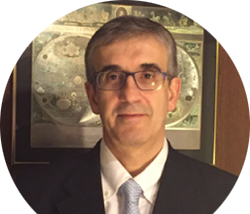
Dimitrios I. Fotiadis
University Professor
Prof. of Biomedical Engineering, University of Ioannina / IMBB-FORTH
Head of the Unit of Medical Technology and Intelligent Information Systems
Editor in Chief IEEE Journal of Biomedical and Health Informatics, Ioannina, Greece
Abstract
Atherosclerotic plaque growth leads to the progressive luminal stenosis of the vessel, which may erode or rupture causing myocardial infarction or stroke. Atherosclerosis is considered a major cause of disability and mortality worldwide with great socioeconomic impact and healthcare costs. For this reason, new computational tools that can improve risk stratification and management of atherosclerotic patients are needed. To this end, recent advances on the in-depth phenotyping of the human atherosclerotic plaque tissue, open the road for more accurate modeling of the biological processes of atherosclerosis which coupled with the simulation of the biomechanical forces generated upon the vessel wall can support the prediction of plaque progression and rupture. Furthermore, these multi-level plaque growth models can be used to simulate the development of high risk plaques (lipidic) or stable plaques (calcified) considering also comorbid conditions such as hypertension and diabetes. On the other hand, the development of computational models of plaque growth requires data as well as clinical and biological information which can be used directly at the models or for the improved prediction of the disease progression. A novel strategy for this purpose is the use of virtual populations for the in silico clinical trials. These approaches can provide clinicians with new tools for patient specific modeling and assist clinical decision making and management of atherosclerotic artery disease.
Prof. Dimitrios I. Fotiadis, received the Diploma degree in chemical engineering from the National Technical University of Athens, Athens, Greece, and the Ph.D. degree in chemical engineering and materials science from the University of Minnesota, Minneapolis. He is currently a Professor of Biomedical Engineering in the Department of Materials Science and Engineering, University of Ioannina, Ioannina, Greece, where he is also the Director of the Unit of Medical Technology and Intelligent Information Systems, and is also an Affiliated Member of Foundation for Research and Technology Hellas, Institute of Molecular Biology and Biotechnology, Dept. of Biomedical Research. He was a Visiting Researcher at the RWTH, Aachen, Germany, and the Massachusetts Institute of Technology, Boston. He has coordinated and participated in more than 250 R&D funded projects (in FP6, FP7, H2020, and national Projects), being the coordinator (e.g. INSILC, TAXINOMISIS, HOLOBALANCE, CARDIOCARE etc.) and Technical coordinator (e.g. SMARTOOL, KARDIATOOL, TO_AITION, etc.). He is the author or coauthor of more than 300 papers in scientific journals, 500 papers in peer-reviewed conference proceedings, and more than 50 chapters in books. He is also the author/editor of 30 books. His work has received more than 18,000 citations (h-index=68). He is IEEE EMBS Fellow, EAMBES Fellow, Fellow of IAMBE, member of the IEEE Technical Committee of information Technology in Healthcare, Editor in Chief of IEEE Journal of Biomedical and Health Informatics, Member of the Editorial Board in IEEE Reviews in Biomedical Engineering, Associate Editor for IEEE Open Journal in Engineering in Biology and Medicine and Computers in Biology and Medicine. His research interests include multiscale modelling of human tissues and organs, intelligent wearable/implantable devices for automated diagnosis, processing of big medical data, machine learning, sensor informatics, image informatics, and bioinformatics. He is the recipient of many scientific awards including the one by the Academy of Athens. He is the co-founder of PD Neurotechnology Ltd, UK.
Prof. Gordana Vunjak-Novaković – Columbia University
Title: Engineering Human Tissues for Medical Impact
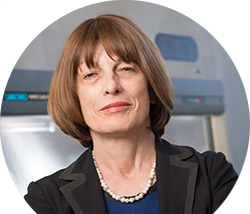
Gordana Vunjak-Novaković
University Professor
The Mikati Foundation Professor of Biomedical Engineering and Medical Sciences
Columbia University in the City of New York, U.S.A.
Abstract
Tissue engineering involves an integrated use of human stem cells, biomaterial scaffolds (providing a structural and logistic template for tissue formation) and bioreactors (providing environmental control, dynamic sequences of molecular and physical signaling, and insights into the structure and function of the forming tissue). In general, our engineering designs are based on biological principles, in order to enable and direct the cells to perform specific functions, by recapitulating the environmental milieu of tissue development, regeneration and disease. In regenerative medicine applications, this approach allows us to tailor the tissue grafts to the patient and the condition being treated. Another tissue engineering paradigm is emerging in recent years, with the development of “organs on a chip” platforms for modeling integrated human physiology. These platforms use micro-sized human tissues that can be functionally connected by vascular perfusion. Derivation of all component cells (tissue specific, supporting, vascular and immune) iPS cells to allow individualized approaches to modeling of disease. To illustrate the state of the art in the field and reflect on the current challenges and opportunities, this talk will discuss some recent advances in bioengineering of anatomically correct bone, whole lung and patient-specific “organs on a chip” for studies of human patho/physiology.
Dr. Gordana Vunjak-Novaković is a Serbian American biomedical engineer. She is a University Professor at Columbia University, as well as the Mikati Foundation Professor of Biomedical Engineering and Medical Sciences. She also heads the laboratory for Stem Cells and Tissue Engineering at Columbia University. She is part of the faculty at the Irving Comprehensive Cancer Center and the Center for Human Development, both found at Columbia University. She is also an honorary professor at the Faculty of Technology and Metallurgy at the University of Belgrade, an honorary professor at the University of Novi Sad, and an adjunct professor at the Department of Biomedical Engineering at Tufts University.
Her focus is on engineering human tissues for regenerative medicine, stem cell research and modeling of disease. Together with her team she has published over 380 scientific papers, 70 book chapters and three books on tissue engineering. Vunjak-Novakovic has also given 380 invited lectures across the world and is named as co-inventor on 100 licensed, issued and pending patents. Building on these patents she co-founded four biotech companies: EpiBone, TARA Biosystems, Xylyx Bio, and Immplacate Health. Additionally, she is a frequent advisor to the federal government on tissue engineering and regenerative medicine.
Biography
Vunjak received her B.S., M.S., and Ph.D. in chemical engineering from the University of Belgrade, in Belgrade, Serbia, her birthplace. After her postgraduate study in Germany, she returned as a faculty to the University of Belgrade in its Chemical Engineering Department. She was a Fulbright Fellow at Massachusetts Institute of Technology’s Harvard-MIT Division of Health Sciences and Technology from 1986 to 1987 and held joint appointments as research scientist at the Whitaker College of Health Sciences and Technology at MIT (1993-1998) and as adjunct professor in the Department of Biomedical Engineering at Tufts University (1994-2004). In 1998 she became a full-time principal research scientist with the Harvard-MIT Division of Health Science and Technology at MIT, where she collaborated, among others, with renowned biomedical engineer Robert S. Langer. In 2005, she accepted a position as full professor with the Department of Biomedical Engineering at Columbia University. She is married to Branko Novakovic, an architect, and they have a son Stasha who is practicing pulmonology and critical care in Miami.
Prof. Valentin Djonov – University of Bern
Title: Microbeam Radiotherapy: How Engineers Can Help Treat Cancer

Valentin Djonov
University Professor
Director Institute of Anatomy, University of Bern
President Swiss Clinical Anatomy, Berne, Switzerland
Abstract
Despite significant advances in the field, the efficacy of radiation therapy for many radioresistant tumors remains suboptimal with current therapeutic doses. A new sophisticated technique called Microbeam Radiation Therapy (MRT) was created by a large bioengineering team; MRT allows a higher dose prescription than conventional radiotherapy (CONV) without causing complications in normal tissue. This is achieved with ultra-high dose rates, orthovoltage photon energies, and non-uniform dose distribution. In preclinical studies, MRT significantly improved the therapeutic ratio compared with CONV in several cancer models with clinically poor prognosis, including radioresistant glioblastoma and melanoma.
In a mouse glioblastoma model, MRT in combination with cisplatin reduced tumor volume 6-fold compared with cisplatin alone and 60-fold compared with untreated mice. In a murine B16-F10 melanoma model, temporally fractionated MRT (peak doses of 133Gy x 3) ablated 50% of tumors and prevented organ metastases and local recurrences for 18 months after treatment. To our knowledge, this is the best treatment outcome ever achieved in preclinical models. The radiation biology underlying the “MRT effect” appears to follow a completely new paradigm of radiation-tissue interactions. In addition to killing tumor cells by extra-high peak radiation doses, several novel biological mechanisms contribute to treatment success: (i) In the range of 400-600 Gy peak dose, MRT selectively disrupts immature tumor vessels while sparing the mature vasculature of the surrounding normal tissue, implicating MRT as a completely novel, anti-angiogenic, tumor-vascular disrudisruptive strategy; (ii) MRT peak doses in the range of 100-150 Gy temporally increase tumor vascular permeability, creating a transient “transpermeability window” that has been identified as an efficient drug delivery system with high therapeutic potential; (iii) tumor vessels disrupted by MRT serve as a gateway for circulating immune cells to invade tumor tissue, resulting in enhanced anti-tumor immune responses; (iv) gene expression analysis of MRT-irradiated tumors identified a specific gene signature for an ‘MRT-induced immune effect’, involving myeloid cell recruitment and interferon responses.
These unique features support MRT as a novel therapeutic approach for the treatment of inoperable, radioresistant lesions.
After few years of general and neurosurgery in 1992 Dr. Valentin Djonov entered a research position at Department of Clinical Research, University of Bern, Switzerland.
In 1995 he became a Research Assistant at the Division of Developmental Biology, Institute of Anatomy, Bern. Followed Habilitation (Assistant Professor) for Gross Anatomy, Histology and Embryology in November 2002 and Associate Professor since March 2006 at the same institute. In September 2007 V. Djonov was promoted to Full professor and Co-director at Institute of Anatomy, Fribourg, Switzerland. In 23010 he returned back to Bern as a Director of the Institute of Anatomy.
Valentin Djonov published more than 240 peer reviewed original research articles, and 50 review articles and book chapters with almost 12’000 citations. The scientific interest of his group next to the vascular imaging and vascular biology concentrate on the Microbeam Radiation Therapy (MRT). MRT is an innovative, radically new approach in radiation oncology that was developed at large third generation synchrotrons. A collimator subdivides the homogeneous radiation field into planar micrometre wide high dose areas separated by a few hundred micrometres wide low dose regions. Our preclinical investigations clearly document that MRT effectively destroys tumours while preserving the surrounding healthy tissues. The underlying radiobiological mechanisms are vascular related, fundamentally novel, and open paradigm shifting new opportunities in cancer treatment.
Prof. Paolo Decuzzi – Italian Institute of Technology
Title: Multifunctional Nanoconstruct:
In Silico Design, In Vitro Characterizations, In Vivo Validation
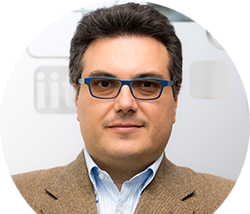
Paolo Decuzzi
University Professor
Laboratory of Nanotechnology for Precision Medicine
Italian Institute of Technology, Genova, Italy
Abstract
Most nanoparticles for biomedical applications originate from the self-assembling of individual constituents through molecular interactions and have limited geometric control and stability. Multifunctional nanoconstructs are hierarchically organized multiscale systems designed for the ‘smart’ delivery of therapeutics and imaging agents. Here, the computational design, manufacturing, in-vitro bio-pharmaceutical and preclinical in-vivo validation of multifunctional polymeric nanoconstructs will be presented and critically analyzed. Specifically, the focus will be on nanoconstructs whose size can be modulated from a few tens of nanometers to several microns; shapes can be spherical, cubical, and discoidal; surface properties are dictated by different coatings; and the mechanical stiffness varies from cell-soft to bone-rigid. These are the 4S parameters – size, shape, surface, stiffness – which can be precisely tuned in the synthesis process enabling the disease- & patient-specific design of multifunctional nanoconstructs. Implications for the treatment and detection of cancer (brain and breast malignancies) and chronic inflammatory diseases (osteoarthritis and inflammatory bowel disease) will be discussed.
Dr. Paolo Decuzzi is currently a Senior Researcher and Professor of Biomedical Engineering at the Italian Institute of Technology (IIT) in Genova where, in July 2015, he founded the Laboratory of Nanotechnology for Precision Medicine. He has been serving as an Associate Professor of Biomedical Engineering at The University of Texas Health Science Center (Houston, TX-USA) from 2007 to 2010 and as a Professor of Biomedical Engineering and Translational Imaging at the Methodist Hospital Research Institute (Houston, TX-USA), until July 2015. His Laboratory in IIT is involved in the rational design of multi-functional nanoconstructs for the treatment and imaging of cancer, cardiovascular and neurodegenerative diseases, the fabrication of microfluidic chips for the rapid screening of novel molecular and nano-based therapeutic agents; the development of multi-scale, hierarchical computational models for predicting the transport and therapeutic efficacy of nanoconstructs; as well as in the organization of dissemination activities at the interface between engineering and biomedical sciences. In this context, he has published over 180 peer-reviewed journal articles and book chapters, generated multiple patents and patent applications. His research activities have been funded by multiple organizations, including NCI, DOD, State of Texas, ESF, ERC, MSCA, and private enterprises, totaling over $15 million. He has been serving on review panels for the NIH, ERC, ESF and for several national Research Agencies.
Prof. Emil Jovanov – University of Alabama in Huntsville
Title: Synergistic Personal Area Networks (SPANs) in IoT Environment: Applications and Opportunities
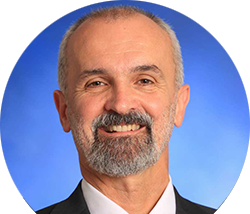
Emil Jovanov
University Professor
Electrical and Computer Engineering Department, University of Alabama in Huntsville, U.S.A.
Abstract
Recent exponential increase of smart sensors and devices integrated into the Internet of things (IoT) environment transformed our homes and industries, while wearable monitoring and mobile health (mHealth) revolutionized healthcare diagnostics and delivery. “Things” with embedded activity and vital sign sensors that we refer to as “smart stuff” can interact with wearable and ambient sensors in Synergistic Personal Area Networks—SPANs. SPANs creates a dynamic “opportunistic bubble” for ad-hoc integration with other sensors of interest around the user, wherever they go. The synergy of information from multiple sensors can provide: (a) New information that cannot be generated from existing data alone, (b) user identification, (c) more robust assessment of physiological signals, and (d) automatic annotation of events/records. We present possible new applications, opportunities and challenges of SPANs and results of feasibility studies. Continuous long-term monitoring of user’s activity and vital signs can provide better diagnostic procedures, early detection of certain conditions, such as onset of COVID, monitoring of chronic patients, and personalized feedback to motivate a proactive approach to health and wellbeing.
Dr. Emil Jovanov is Professor in Electrical and Computer Engineering Department at the University of Alabama in Huntsville. He received his Dipl. Ing., MSc, and PhD from the University of Belgrade in Computer Engineering. He was Research Scientist at Institute Mihajlo Pupin in Belgrade from 1984 – 1998, and Assistant Professor at School of Electrical Engineering, University of Belgrade from 1994-1998. Since 1998, Dr. Jovanov is with the Electrical and Computer Engineering Department at the University of Alabama in Huntsville.
Dr. Jovanov has more than 35 years of experience in the design of application specific hardware and software systems and biomedical signal processing. Dr. Jovanov is recognized as the originator of the concept of wireless body area networks for health monitoring and one of the leaders in the field of wearable health monitoring. Dr. Jovanov is an IEEE Fellow, and serves in IEEE EMBS Technical Committee on Wearable Biomedical Sensors and Systems. He is a member of the Conference Editorial Board and Theme 7 Editor (Biomedical Sensors and Wearable Systems) of IEEE Engineering in Medicine and Biology Society, Associate Editor of the IEEE Access, IEEE Journal of Biomedical and Health Informatics (JBHI), IEEE Transactions on Biomedical Circuits and Systems (TBCAS), and IEEE Open Access Journal of Engineering in Medicine and Biology (OJEMB), and Editorial Board member of Applied Psychophysiology and Biofeedback. Dr. Jovanov was the Guest Editor of two special issues of IEEE Transactions on Information Technology in Biomedicine: “Body Sensor Networks: From Theory to Emerging Applications” (2009) and “M-Health: Beyond Seamless Mobility and Global.
Prof. Saša Kenjereš – Delft University of Technology
Title: On Current Achievements and Challenges in Combined Experimental and Numerical Studies of Blood Flow in the Patient-Specific Left Ventricle
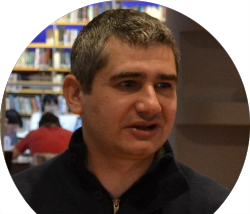
Saša Kenjereš
University Professor
Department of Chemical Engineering, Faculty of Applied Sciences, Delft University of Technology and J.M. Burgerscentrum Research School in Fluid Mechanics, Delft, Netherlands
Abstract
Blood flow patterns in the human left ventricle (LV) are of particular interest in the study and early diagnosis of LV dysfunction, with a primary focus on the trans-mitral jet and the intra-ventricular vortex dynamics that occur between filling and ejection. Experimental challenges originate from the underlying flow structure, which is intrinsically complex, three-dimensional, and unsteady. In the present work, we apply and analyze a series of state-of-art experimental techniques including Ultrasound (US), Particle Imaging Velocimetry (PIV), and Magnetic Resonance Imaging (MRI) – all performed under identical experimental conditions for a pulsating flow in an optically transparent dynamic model of the human left ventricle with biological valves. We discuss in detail the effects of the spatial and temporal resolutions on capturing the most salient flow patterns. Finally, experiments are compared with the results of a computational fluid dynamics (CFD) solver based on a newly developed computationally efficient dynamic meshing morphing approach with the radial basis function.
Dr. Saša Kenjereš is a Full Professor of Applied Physics and Chemical Engineering at the Delft University of Technology, Delft, The Netherlands. He received his Ph.D. in Applied Physics in 1999 at the Delft University of Technology, The Netherlands. From 2001 to 2005 he was a Research Fellow of the Royal Netherlands Academy of Sciences and Arts (KNAW). From 2005 to 2006 he was a Burgers Visiting Associate Professor at University of Maryland, College Park, USA, Institute of Physical Science and Technology, Computer and Space Science/Earth Systems Science Interdisciplinary Center. He received ERCOFTAC (European Research Community on Flow, Turbulence, and Combustion) and Leonhard Euler Centre Visitor Fellowships at ETH Zurich, Switzerland (2002, 2003, 2004, 2008, and 2014). He was the Marie-Curie Visiting Professor at the AGH University of Science and Technology, Krakow, Poland (2007, 2008, 2009, 2010, 2011, 2013). His research interests include: (i) multiscale transport phenomena in biomedical applications (experiments and simulations); (ii) advanced fluid dynamics, heat and mass transfer, and turbulence (mathematical modeling, simulations, and experiments); (iii) coupling fluid mechanics and electromagnetism (magnetohydrodynamics, MHD); (iv) environmental flows, turbulent dispersion in complex urban areas, atmospheric chemistry and crowd behavior; (v) high-performance supercomputing (HPC);
Further Information
Email: bibe2021@kg.ac.rs
